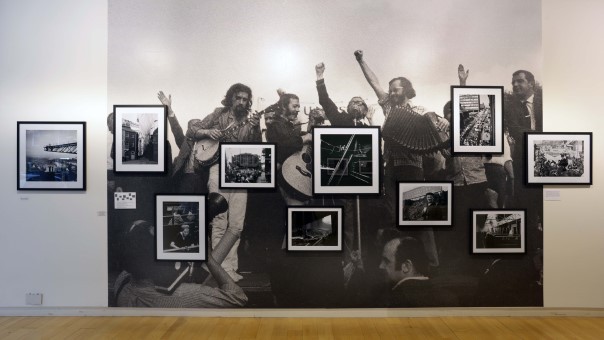A major retrospective of Oscar Marzaroli’s work no doubt holds special significance for Weegies past and present, depicting a defined time period in Glasgow’s turbulent social history. The relationship locals have with these images will vary in nature according to when and how their frame of reference aligns – falling somewhere between vague nostalgia, dreams of family, and genuine warm remembrance. As I make my way through Street Level I weave between huddles of people trying to decipher where and when things were, matching their memories to the physical prints, tracing buildings familiar to them as they retreat somewhere into their memories of the city. I’ve never lived in Glasgow, but I don’t think it’s fair to say that these pictures will only have impact for those that were part of their depicted world. Instead of some shared nostalgia I slip into an imagined past, populated by the folk in the pictures and frozen by Marzaroli’s shutter. I see Glasgow through new eyes– in broken brick, cigarette ends, new beginnings, sunsets, cranes and crumbling concrete.
Marzaroli’s Glasgow is a city dominated by faces, characters and stories. Skylines and chimneys punctuate the work – they set the scene – but this is an exhibition about people and then place in that order. I guess what I mean is that we learn about Glasgow through the kids playing on the street, the ladies nattering on corners and the crowds watching football. It is rooted in the physicality of place and the prospect of the immediate nearby. Depicted ‘landscape’ is not the unifier here, the notion of shared space is. It would be twee indeed to return to the marketing mantra of ‘people make Glasgow’ but in this exhibition it appears to be true.
Beyond this, I’m aware of a backdrop of a changing city, and these photographs present a public necessarily engaged with what is happening around them. Peter, the central of The Castlemilk Lads, stares at the camera with a frankness that is almost alarming. He has an open and unwavering defiance that seems bizarre to consumers of the social photo today: selfies, filters, snapchat, always disappearing, always re-framing ourselves. A different kind of impermanence is illustrated here – the uncertainty of city demolition and redevelopment. The contact between photographed and photographer is so direct and so different to how aware we are of cameras today; a testament to a different time, but also to Marzaroli’s approach.
Curatorially, the many varied presentation techniques are to me a little distracting, and the layered works fall flat. I imagine this was designed to simulate being in a crowd: snatching faces here and there in the clamour of the city. I’m no believer in the strict necessity of linear framed work on a white wall – but the pops of colour, myriad print methods and overlapping frames/vinyls seems unnecessary. Photographic memorabilia also accompanies the work – it’s refreshing to see Marzaroli’s original silver gelatin prints, especially the ones which are imperfect and full of dust, and on a nerdy level it’s interesting to see his shooting list. But some of it almost feels archaeological: the old cameras, the rusty film canisters as spectacles behind glass – it feels at odds with a Gallery offering darkroom facilities and courses to keep analogue photography in the forefront of contemporary practice.
This said, the exhibition overall is a real treat, and strikes a good balance between personal and public in its curation of a mammoth collection of work. I’m very aware that this exhibition is not meant for me. It is Glasgow, for Glasgow, told with love. But despite my distance I’m allowed to dream a little, offered instead a peek at a time and place lost to all but a few. The work speaks of the permanence of photography to aid the fragility of nostalgia. And to my own surprise, it is with joy and not alarm, that I watch folk tapping the glass, leaning to touch the faces of those remembered from before.












